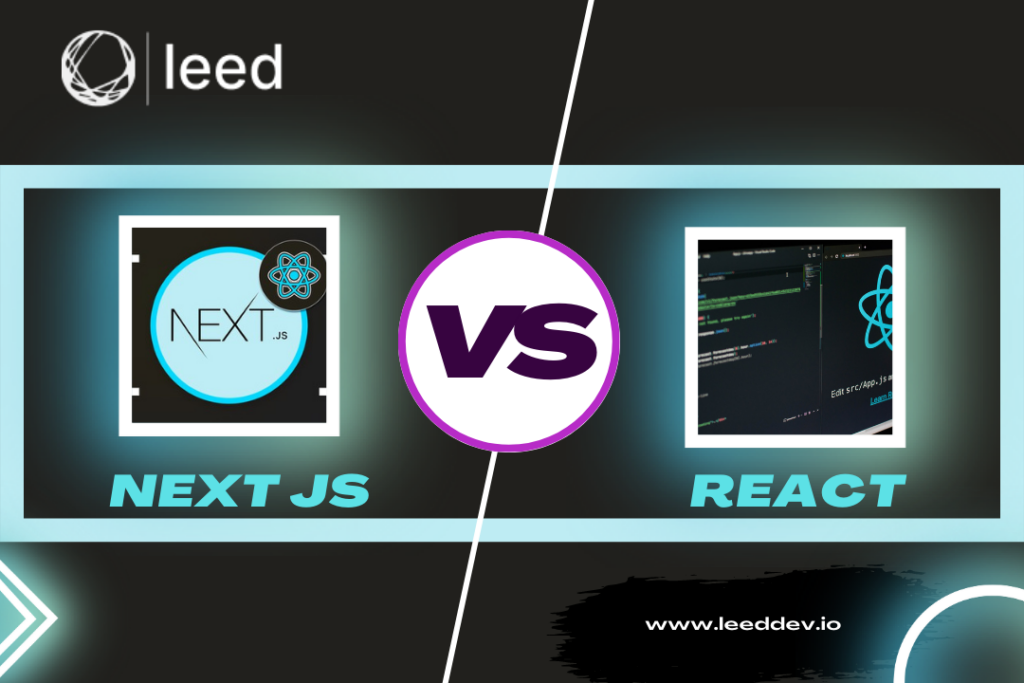Choosing the right technology for your project can feel like a maze. Especially when two powerful options React and Next.js dominate the web development space. Both are built on JavaScript both are popular and both deliver exceptional results but they shine in different ways.
If you’re wondering which one suits your need this blog will help you decide. From Next Js vs React popularity to Next Js vs React performance, let’s explore their key features, advantages and the unique scenarios where each excels.
Ready to uncover which one is the perfect fit for your next project? Let’s dive in!
What is Next.js?
Next.js is an open source React framework developed by Vercel that empowers developers to build user friendly & SEO optimized apps. Released in 2016 it has become a favorite for creating dynamic websites & static apps.
Its standout feature server side rendering ensures faster load times and improved search engine visibility making it perfect for blogs, landing pages and complex applications. Trusted by industry leaders like TikTok, Target, and The Washington Post, Next.js continues to be a top choice for modern web development.
Features of Next JS
Before discussing Next Js vs React lets discuss the main features. Some of the main features of Next JS are as follows:
Hot Code Reloading
With this feature, any changes made to the code are instantly visible in the browser without a full page refresh. This fast refresh process enhances the development experience by making testing and debugging quicker.
Automatic Code Splitting
Next.js automatically divides your JavaScript code into smaller chunks, ensuring that only the necessary code for each page is loaded. This reduces page load times and keeps the application lightweight.
Ecosystem Compatibility
Next.js is designed to work smoothly with the React and Node.js ecosystems allowing developers to use existing skills and tools while gaining the benefits of Next.js specific features.
Server Side Rendering
SSR allows pages to be rendered on the server instead of the client resulting in faster page loads and improved SEO. This is particularly beneficial for content heavy or dynamic websites.
Static Site Generation
Pre-renders pages during the build process, serving them as static HTML files. This is ideal for content that doesn’t change frequently, such as blogs or documentation, ensuring quick delivery and reduced server load.
Automatic Routing
Next.js simplifies routing with a file-based system. By creating files in the pages directory, routes are automatically generated, eliminating the need for complex route configurations.
Image Optimization
The built-in next/image component optimizes images by supporting modern formats like WebP, lazy loading, and responsive images. This results in faster load times and better user experiences.
Prefetching
Next.js preloads resources for routes that are within the viewport, ensuring faster navigation when users click on those links.
Font Optimization
The next/font package automatically optimizes fonts, supports Google and local fonts, and eliminates external requests. This leads to better performance and reduced layout shifts.
Script Optimization
The next/script package ensures third-party scripts are loaded efficiently. Developers can choose when and how scripts are loaded using strategies like beforeInteractive or lazyOnload.
Route Handlers
Simplifies server-side operations such as handling HTTP requests, fetching data from databases, and integrating with APIs. It supports HTTP methods like GET and POST for dynamic server-side logic.
React Server Components
Allows components to be rendered on the server, reducing client-server data fetching trips and improving performance. While server components can’t perform client-side operations, they work well for data-intensive tasks.
Advantages of Next JS
| Feature | Description |
| Improved Performance | SSR generates HTML on the server, enabling faster page loads. Includes built-in image, script, and font optimization. |
| SEO-Friendly | SSR allows effective crawling and indexing, boosting search engine rankings for better organic traffic. |
| Code Splitting | Automatically loads only necessary JavaScript per route, reducing initial load time and improving UX. |
| Great Developer Experience | Built-in features like routing, SSR, and optimizations streamline development. TypeScript support and documentation enhance productivity. |
| Speed | Supports static site generation and SSR for fast, pre-rendered pages served via CDN. |
| Minimal Setup | Features like automatic routing require no additional configuration, simplifying development. |
| Custom Back-End | Easily create back-end functionalities without impacting client-side bundle size. |
| Built-In CSS Support | Enables seamless CSS integration without extra tools, reducing complexity in smaller projects. |
Limitations of Next JS
| Limitation | Description |
| Development and Maintenance | Requires skilled developers and ongoing resources for maintenance. |
| Vendor Lock-In | Next.js uses its own standards, making it harder to configure certain tools like webpack to personal preferences. |
| Routing System | The routing system ties logic closely to pages, making it hard to maintain and modify routes frequently. |
| Community | Smaller community compared to other frameworks, making it harder to find solutions and resources. |
| No Built-In State Management | Lacks built-in state management, requiring third-party libraries like MobX or Recoil, which adds complexity. |
What is React?
React is an open source UI library created by Meta (formerly Facebook) to build dynamic, event-driven web applications. It allows developers to write components in JavaScript (or TypeScript) that can be reused across applications, promoting efficiency. Unlike traditional websites, which reload the entire page for data changes, React only re-renders the components affected by the state change, leading to faster updates. React is declarative, meaning developers have full control over the workflow, making it a powerful tool for creating responsive and interactive user interfaces.
Features of React JS
Main features of React JS are as follows:
JavaScript Syntax Extension
JSX is a combination of JavaScript and HTML that makes creating React elements easier. It allows you to embed JavaScript expressions inside HTML-like code. While browsers don’t natively support JSX, it is compiled by Babel into JavaScript, simplifying development. This syntax extension makes the code more readable and familiar for developers who know HTML and JavaScript.
Virtual DOM
The Virtual DOM is a lightweight copy of the real DOM. Instead of updating the entire DOM when a change occurs, React first updates the Virtual DOM and compares it with the real DOM. Only the changed parts are updated, making React more efficient and faster in rendering updates.
One-way Data Binding
In React, data flows in a single direction, from parent components to child components. This simplifies data management because child components cannot directly modify the data they receive; instead, they communicate with the parent to update the state. This one way flow makes application more predictable and easier to debug.
Performance
React use of the Virtual DOM ensures that only the necessary parts of the UI are re-rendered which optimizes performance. By updating only the modified components, React reduces the load on the browser ensuring a faster and smoother user experience.
Component Based Architecture
React structures UIs using reusable components, each managing its own logic and behavior. These components can be nested, reused, and composed to build complex UIs. This modular approach improves code maintainability and allows for better organization in large applications.
Advantages of React
| Advantage | Description |
| Fast, Efficient, and Easy to Learn | Pre-built patterns and functions for fast, scalable projects; requires only basic HTML and CSS knowledge. |
| SEO Friendly | React’s Single Page Application (SPA) can be rendered and indexed for better SEO visibility. |
| Write Once, Run Anywhere | Code reusability across web, iOS, and Android using React Native without rewriting existing code. |
| Simple | Component-based approach with JSX makes React simple to learn and build applications. |
| Easy to Learn | Extensive documentation and community support make React easy for beginners. |
| JavaScript Syntax Extension (JSX) | JSX combines JavaScript and HTML, optimized by Babel for better performance. |
| Reusable Components | Components can be reused throughout the app, improving code readability and maintainability. |
| Performance Enhancement | Virtual DOM updates only the necessary parts, improving app speed and responsiveness. |
| SEO Friendly | Server-side rendering improves content visibility and SEO performance. |
| Easily Write Unit Tests | Component-based structure and available libraries make testing easy and effective. |
Limitations of React
| Limitations | Description |
| Lack of Proper Documentation | Fast updates lead to sparse or incomplete documentation, making it hard for developers to keep up. |
| Development Speed | Constant updates can result in a steep learning curve, requiring developers to frequently relearn new processes. |
| JSX Complexity | Mixing HTML and JavaScript in JSX can be confusing for new developers, complicating the learning process. |
| Fast-Developing | The rapid pace of React’s development makes it hard to keep up, leading to bugs and instability in applications. |
| Complex Documentation | React’s growing size and complexity make its documentation difficult to navigate, with outdated examples and insufficient explanations. |
| Re-Rendering | Unnecessary re-rendering occurs due to React’s component life-cycle and JavaScript’s handling of comparisons, affecting performance. |
Difference Between React and Next JS
Now coming to the topic of Next Js vs React, go through the table to know more:
| Feature | React | Next.js |
| Definition | A JavaScript library for building UI components. | A framework built on React, adding features like SSR and SSG. |
| Purpose | Focuses on the view layer for single-page applications. | Full-stack framework for building web apps with server-side rendering (SSR), static generation (SSG), and routing. |
| Server-Side Rendering (SSR) | No built-in support for SSR; typically client-side rendered. | Built-in SSR support for faster page loads and better SEO. |
| Routing | Requires third-party libraries like React Router for routing. | Built-in file-based routing system. |
| Static Site Generation (SSG) | Not available natively. Needs additional setup. | Supports SSG, generating static pages at build time for faster loading. |
| Performance Optimization | Manual code splitting and optimizations needed. | Automatic code splitting and optimized performance features. |
| Setup Complexity | Simple to set up; requires configuring additional features. | Slightly more complex but provides a ready-to-use setup for routing, SSR, and SSG. |
| Use Case | Best for SPAs or when building custom solutions. | Ideal for dynamic websites or applications with static and server-rendered pages. |
Which is Better Next JS vs React?
Next.js simplifies coding with less boilerplate compared to React, making it a good choice for static websites or JAMstack applications. React, however, is better suited for complex web apps with heavy data-driven components and complex routing.
Should I Learn Next.js or React?
While Next.js builds upon React you don’t need to be an expert in React to learn Next.js but a basic understanding is necessary. If you’re new to React it’s recommended to start with official tutorial before diving into Next JS. Understanding the purpose and use of Next JS will help you grasp its full potential.
Wrapping It Up!
React is perfect for building complex web applications with heavy data-driven components and custom solutions. On the other hand, Next.js excels at creating SEO-friendly, fast-loading websites, offering built-in features like server-side rendering (SSR) and static site generation (SSG).
If you’re new, start with React to grasp the fundamentals, as Next.js builds on its foundation. Both have their strengths, and the choice depends on your project’s requirements.
Need expert guidance for your next web project? Leed Software Development provides best Next js vs React solutions designed to your goals.
FAQs
What is the key difference between React and Next.js?
React is a UI library for building components, while Next.js is a React-based framework offering SSR, SSG, and built-in routing.
Which is better for SEO, React or Next.js?
Next.js is better for SEO due to server-side rendering (SSR) and static site generation (SSG).
Is Next.js harder to learn than React?
Not necessarily. A basic understanding of React is enough to learn Next.js, but it has more built-in features.
When should I choose React?
Choose React for complex, single-page applications (SPAs) with heavy data processing.
When should I choose Next.js?
Next.js is ideal for SEO-friendly, fast-loading, and dynamic websites like blogs, e-commerce, or landing pages.
Can I use React without Next.js?
Yes, React can be used independently. However, Next.js adds features like SSR and routing to enhance functionality.
Does Leed Software Development work with React and Next.js?
Yes! Leed Software Development offers tailored solutions using both React and Next.js for diverse project needs.




